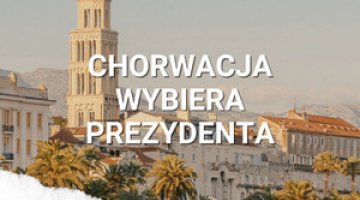The new face of Croatian right wing
On 19th October a new centre-right Croatian government, formed by the Croatian Democratic Union (HDZ) and the Bridge of Independent Lists (Most) party, won a confidence motion. This marks the end of a nearly year-long period of political instability which brought about a snap election in September this year. The new government of Andrej Plenkovic, dominated by the HDZ, has announced economic reforms and reforms of the bureaucratised administration. While Germany remains Croatia’s main partner in the EU, the new government has announced closer co-operation with Central European countries. Croatia will be still seeking for the countries in the Western Balkans to be integrated into the EU and NATO. It should be expected that it will continue its active policy in the former Yugoslavia, mainly focusing on supporting the Croatian minority in Bosnia and Herzegovina. Unlike the former Croatian government, the Plenkovic cabinet is likely to step back from placing an emphasis on historical policy, which has resulted in the polarisation of society and tensions in Croatia’s relations with Serbia.
A change in the image of the Croatian right wing
A conflict between Tomislav Karamarko (the deputy prime minister and the leader of HDZ) and Prime Minister Tihomir Oreskovic directly brought about the collapse of the first coalition of HDZ and Most. As a consequence, the government was toppled and the then HDZ leader was forced to step down in the face of a snap election. Andrej Plenkovic, a former Member of the European Parliament and a secretary of state for European integration in the Ministry of Foreign Affairs, took the position of prime minister. After taking the reins of the party, Plenkovic installed his own people in the most important positions in HDZ, thus marginalising the faction which remained loyal to Karamarko. In the party’s election manifesto he focused on economic solutions which will be welcomed in society, and avoided historical and ideological issues (such as holding communism to account and contesting Yugoslavia’s political and cultural legacy). Thanks to this HDZ has changed its image to a more centrist one, which has enabled the party to improve its result in comparison with the 2015 election.
Unlike the previous coalition of HDZ and Most, the Plenkovic government can be very optimistic that it will see out its term. The coalition has 75 of the 151 seats in parliament but, as was shown in the vote of confidence, it can also rely on support from the Croatian Peasant Party and representatives of national minorities (also in exchange for an increase in financial support for these minorities). In the longer term it is the mobilisation of HDZ’s internal opposition that will be the greatest problem for the Plenkovic government since it is likely to challenge the government’s reforms by putting their social costs in the spotlight.
Economic reforms
The establishment of a stable governmental coalition provides a chance for the introduction of economic reforms which have long been postponed. Almost all of the new government departments responsible for economic issues (these competences are spread across several ministries) are controlled by HDZ but the government’s policy in this area has been clearly influenced by the reformist demands of Most. The government intends to boost the Croatian economy (in 2015 GDP increased by 1.6%) by fiscal and administrative incentives for small and medium-sized enterprises. These measures are also set to help reduce Croatia’s unemployment rate which stands at approximately 16% (according to Eurostat, it is the third highest unemployment rate in the EU). The reforms will be supervised by two deputy prime ministers: the minister for the economy (HDZ) and the minister of public administration (Most). This may lead to frictions since Most will be determined to prove that it is the main driving force behind the positive changes in the country.
It should also be expected that the reforms will be linked to important social costs, the more so that Croatia has the largest national debt in the region (86.7% of GDP in 2015) and a high deficit in the public finance sector (3.2% of GDP in 2015; this year the European Commission predicts it will drop to 2.7% of GDP) and because of this the country has been subject to the European Commission’s excessive deficit procedure. The reforms announced by the Plenkovic government may turn important groups of interest in the country against the government. Changes in the functioning of the public administration (e.g. a periodic assessment of civil servants, the simplification of procedures) are likely to be met with resistance from civil servants. The scrapping of certain para-taxes which go to the budgets of the counties may lead to conflict with local governments and thus with HDZ’s party hinterland.
In its energy policy the government has announced it will take action to strengthen Croatia’s energy security by investing in infrastructure which will enable stable supplies of oil and gas to the country. However, no mention is made in the government’s policy that an LNG terminal will be built on the island of Krk as an element of a North-South gas corridor.
Foreign policy and European policy continued
Closer co-operation with the countries which determine EU and NATO politics remains Croatia’s priority in its foreign policy. In the most important issues in EU politics the Plenkovic government will pursue solutions proposed by Germany. As for the migration crisis, Plenkovic does not want to build fences on the Croatian border and opts for collaboration with the partners in the region. The new Croatian government also intends to strengthen its co-operation with the US, which it sees as a counterbalance to Russia’s influence in the territory of the former Yugoslavia. Croatia will seek to play the role of a promoter of Euro-Atlantic integration in the Balkans.
Developing closer relations with the most influential countries in the EU and NATO will be supplemented by strengthening the ties with the Visegrad states and more broadly with the countries from Central Europe. It should be expected that the government will better coordinate its policies with President Kolinda Grabar Kitarovic who was a member of HDZ and the main promoter of co-operation in the Baltic-Adriatic-Black Sea triangle. Croatia’s priority in this area is to develop transport corridors, above all in order to strengthen the role of the Adriatic port in Rijeka.
A détente should be expected in Croatia’s relations with Serbia, which have been quite tense recently. This is particularly the case due to the fact that there are no politicians in this government associated with confrontational rhetoric against Belgrade. Although the Plenkovic government will tone down the nationalist rhetoric, historical issues will remain a challenge in bilateral relations between the two countries. The Croatian government will continue to defend the interests of war veteran groups (for example opposing the possibility for Croatian veterans suspected of war crimes to appear in the Serbian courts). On the other hand, it will probably avoid escalating disputes. The new Croatian government will continue its active policy in Bosnia and Herzegovina (the prime minister will go to Sarajevo on his first state visit). Zagreb will also focus on supporting the demands of Bosnian Croats who are seeking to establish their own entity within Bosnia and Herzegovina.




